Author: Steve Crum
Complex ‘Emilia Pérez’ stuns with brilliant acting, writing
 By Steve Crum
By Steve Crum
Originality is Emilia Pérez. Just sum up this mind boggling Jacques Audiard masterpiece. Audiard produced, directed and wrote both the screenplay and the opera libretto it is based upon. (It is also adapted from Boris Razon’s novel, Écoute.)
Describing EP as a musical crime comedy might sound odd, but so be it. Its 132-minutes weave from gangster drama and violence to love story  to song and dance sequences. The blend may be jaw dropping, but it all seems right.
to song and dance sequences. The blend may be jaw dropping, but it all seems right.
Vaguely reminiscent of 1992’s The Crying Game, written and directed by Neil Jordan, EP follows a unique plot line that is much more complex. Realize too that the lead character in Emilia is a transgender cartel boss…played by the transgender actress Karla Sofia Gascón! Score another uniqueness point for originality.
Factor in that before he has “gender affirming surgery,” Emilia is known as Juan “Manitas” Del Monte, married to Jessi (well played by Selena Gomez) and father of their two children. In hoodlum parlance, Jessi is on the lamb from enemies. He wishes to appear killed—by going into hiding and undergoing a body and identify makeover— to protect his family.  Even his wife is unaware, and mourns his “death.”
Even his wife is unaware, and mourns his “death.”
At the outset of the plan, (then) Juan persuades a so-so but talented Mexican attorney to handle his affairs during the upcoming transition—that is filled with complications. Zoe Saldaña plays Rita Mora Castro, who does terrific work from dramatics to singing and dancing when the story segues into near opera. Equally stunning is the music composed by Clément Ducal (score) and Camille (songs).
That Emilia not only misses her wife and kids, but decides to push her charade to actually move in with them disguised as Juan’s  sister…is enough of too much reveal.
sister…is enough of too much reveal.
Here is an amazing motion picture, truly original.
—————
GRADE on an A-F Scale: A
‘Horizon’ is majestic in scope, but major disappointment
 By Steve Crum
By Steve Crum
Kevin Costner’s epic western, Horizon, should have been better. It saddens me to say such because I am both a huge fan of the western genre plus a Costner fan. His Dances With Wolves remains an all-time classic.
But now comes Horizon.
Horizon, officially titled Horizon: An American Saga—Chapter 1, is a sprawling (in the true sense) 181-minutes. To be fair, it is difficult to judge the film since it is only 1/4 of the whole story. Yes, there are four, count-em, parts—three yet to be released. Although there are some interesting set pieces in this first chapter, like dissent among the Apaches and lawlessness among the Whites, this Horizon is a character study setting up future developments in plot.
One can only imagine the progression of plot among the multitude of characters introduced. Among them is, of course, Kevin Costner, who produced, co-wrote, directed and stars. His Hayes Ellison is a Montana 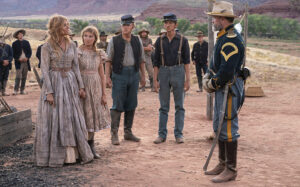 territory horse trader who gets mixed up with a prostitute and murder.
territory horse trader who gets mixed up with a prostitute and murder.
Others in the basic cast of 40+ include Sienna Miller, Sam Worthington, Giovani Ribisi and Michael Rooker.
The storyline centers on Westward migration during 1859 in the Arizona Territory. Handbills advertise settlement in the newly established town of Horizon. Homesteaders are enticed to settle,  despite opposition of opposing Apaches. Of course, the impending danger of such is definitely not mentioned on any advertising circulars. Fast forward to 1863 with the basically tent city burg of Horizon celebrating their new land as Native Americans making armed opposition. A graphic slaughter of men, women and children ensues.
despite opposition of opposing Apaches. Of course, the impending danger of such is definitely not mentioned on any advertising circulars. Fast forward to 1863 with the basically tent city burg of Horizon celebrating their new land as Native Americans making armed opposition. A graphic slaughter of men, women and children ensues.
What follows is retaliation by the cavalry stationed at nearby Camp Gallant as well as greedy, scalp hunting ruffians. The story develops into romances and jealousy at the fort. Cut to Montana violence, life in a railroad work camp, a Santa Fe Trail wagon train, and relentless revenge against Native Americans.
 The aforementioned plot lines have been covered in many aspects since the beginning of the western genre. Costner has emphasized realism and in depth characters in his telling. I really like Costner touches like peering out of a distorted glass window—realistic for that time. In a similar vein, part of a gunfight is via the reflection in a water trough.
The aforementioned plot lines have been covered in many aspects since the beginning of the western genre. Costner has emphasized realism and in depth characters in his telling. I really like Costner touches like peering out of a distorted glass window—realistic for that time. In a similar vein, part of a gunfight is via the reflection in a water trough.
Costner is impressive, as are J. Michael Muro’s cinematography and John Debney’s score. Acting  overall is exemplary.
overall is exemplary.
The picture ends with collage snippets of scenes in the upcoming Horizon—Chapter 2.
Although Chapter 1 pretty much failed at the box office, much to Costner’s and my chagrin, the second part is indeed planned for a 2025 theatrical release.
—————
GRADE on an A-F Scale: C+
Taut ‘Rebel Ridge’ is formula done so well
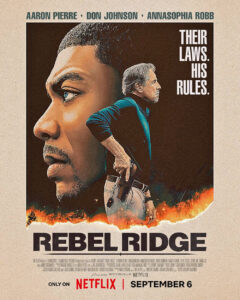 By Steve Crum
By Steve Crum
When former Marine Terry Richmond cycles into a small Louisiana town, it should seem very familiar to action movie fans. The deja vu is because ex-Green Beret John Rambo entered a near-clone looking city in 1982. Back then, the success of Sylvester Stallone’s Rambo character initiated a string of movie sequels. Now, 42 years after First Blood, we have Rebel Ridge. It is a taut, action-packed thriller starring Aaron Pierre as Richmond. And it is well worth seeing.
Richmond’s protagonist is the burg’s police chief, with an uncharacteristic Don Johnson seething violence as a corrupt top cop. (Rambo’s nemesis was the town sheriff played by Brian Dennehy.) In both films, a strong, good guy, out-of-towner is totally unwelcome to law enforcement.
 All that said, director/writer Jeremy Saulnier does a slightly fabulous job in making the plot surprisingly fresh and compelling.
All that said, director/writer Jeremy Saulnier does a slightly fabulous job in making the plot surprisingly fresh and compelling.
After being virtually robbed of his $36,000 (by two local cops) that he brought to help his jailed cousin, Richmond gets zero help from all concerned at police headquarters. Instead, he gets blowback from Chief Sandy Burnne (Johnson) and his underlings. But there is one sympathetic to his cause who faces danger if she takes Terry Richmond’s  side. She is Summer McBride, played by AnnaSophia Robb. Her decision to buck the corrupt legal system of Rebel Ridge and help Richmond threatens her life. Soon the two become a crime busting team.
side. She is Summer McBride, played by AnnaSophia Robb. Her decision to buck the corrupt legal system of Rebel Ridge and help Richmond threatens her life. Soon the two become a crime busting team.
The script’s credibility goes to surprise extremes whereby the two heroes scheme and fight Chief Burnne and his legalized thugs. Realize that Richmond is no Rambo—in the sense that Rambo is a one-man army. Actually, Terry is trying to avoid violence. At the same time, he has to become physical when helping his new comrade stay safe and survive.
Rebel Ridge’s third act is nail-gnawing intense as the forces of good and evil meet resolution. I know it sounds formula, but it works.
Incidentally, David Gallego’s cinematography is above average and worthy of note.
 Calling Terry Richmond a thinking man’s John Rambo is apt.
Calling Terry Richmond a thinking man’s John Rambo is apt.
—————
GRADE on an A-F Scale: A-
20th Anniversary of ‘E. T.’: Still call waiting after two decades
This movie feature originally appeared in The Kansas City Kansan newspaper on March 23, 2002. My original artwork is included.
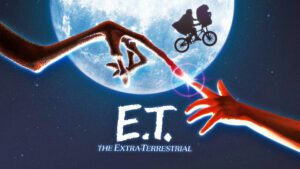
By Steve Crum
The rumors lie. The vulgar words have not been cut out of the 20th anniversary re-release of E. T. the Extra Terrestrial. So “penis breath” and a couple of other mildly off-color remarks made by the film’s children survive. It wasn’t a big deal in the first place, but there were publicity leaks that director Steven Spielberg, along with screenwriter Melissa Mathison, had cleaned up the language in what many consider his greatest motion picture work.
 Be that “breath” as it is, this new take on E. T. is barely changed from the original. The audios and visuals have been digitalized, although I could not discern a difference. Of course, I need to re-see the 1982 original to really compare. But there is a notable scene cut from the original release that IS noteworthy.
Be that “breath” as it is, this new take on E. T. is barely changed from the original. The audios and visuals have been digitalized, although I could not discern a difference. Of course, I need to re-see the 1982 original to really compare. But there is a notable scene cut from the original release that IS noteworthy.
The restored gem occurs as Elliot (Henry Thomas) talks on the phone as the stumpy E. T. teeters on the edge of a bathtub in the background, and soon falls in. 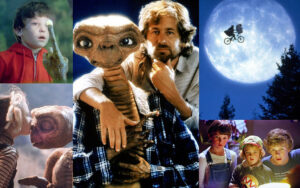 Elliot runs to rescue his friend, followed by E. T. wanting to remain submerged. It’s a cute, laughable scene.
Elliot runs to rescue his friend, followed by E. T. wanting to remain submerged. It’s a cute, laughable scene.
At this point, forgive me. In my haste to divulge the scoop on changes in E. T., I assumed that most of you readers have already seen the movie at least once over the past 20 years, either on screen or video. For those who are in the minority, let me fill you in.
E. T. tells the story of a 10 year-old California boy, Elliot (Thomas), who one day befriends an outer space creature hiding in his backyard storage shed. The short and harmless visitor is stranded on earth after his fellow aliens take off in their space vehicle without him. It is established early on that the outer space botanists land on earth to collect plant specimens for storage in their ship’s greenhouse.
After enticing the thing in the house and upstairs into his room (all by leaving a trail of Reece’s Pieces), Elliot soon confides with his older brother, Michael (Robert MacNaughton) and six year-old sister,  Gertie (Drew Barrymore). Together, throughout most of the movie, they keep their house guest a secret from their mom (former Kansas City, Kansas resident Dee Wallace-Stone).
Gertie (Drew Barrymore). Together, throughout most of the movie, they keep their house guest a secret from their mom (former Kansas City, Kansas resident Dee Wallace-Stone).
As government scientists zero in on the whereabouts of E. T., Elliot find that he emotionally links with the creature—with both comedic and dramatic results. Still a jaded laugh after all these years is when E. T. gets into the home refrigerator while Elliot is at school in science class. As E. T. chugs beer after beer, becoming falling-down drunk, Elliot experiences like results.
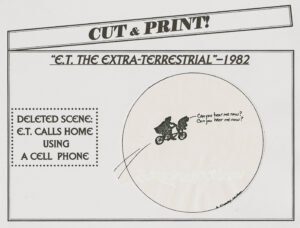 By the time astronaut-suited scientists surround Elliot’s house (reminiscent of the home invasion in Spielberg earlier Close Encounters of the Third Kind), E. T. has learned to talk: “Phone home!” Time for Elliot and family to get their new pal back to his own planet.
By the time astronaut-suited scientists surround Elliot’s house (reminiscent of the home invasion in Spielberg earlier Close Encounters of the Third Kind), E. T. has learned to talk: “Phone home!” Time for Elliot and family to get their new pal back to his own planet.
There is a notable presence of the “Keys” character (Peter Coyote), who is shown waist down from the opening of the film, with a set of keys dangling off his belt. He is the leader of these government hunters, who are interestingly depicted as villains. Incidentally, Coyote’s character is shown full body and face at the end.
The tear-wrenching, Oscar-winning score by John Williams is as effective as ever, and E. T.’s eventual departure still grabs.
In its ending, which echoes sentiments similar to those in The Wizard of Oz, E. T. extolls the virtues of being home…and of loving one’s home. Elliot’s home has been torn by separated parents; and E. T. is separated from his own. Man’s humanity to his fellow man (or creature) is central to Spielberg’s best work—from Schindler’s List to A. I. to this genuine classic, his most popular film.
°°°°°°°°°°
GRADE on an A-F Scale: A
THE KANSAS CITY JOLSON STORY…Part 7: “ROBINSON CRUSOE, JR.”
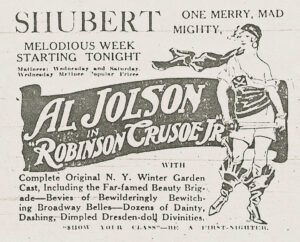 By Steve Crum
By Steve Crum
After “Robinson Crusoe, Jr.” had its initial, New York, Winter Garden run, Feb. 17-June 10, 1916, the national run began. From Aug. 28, 1916 through Nov. 17, 1917, Jolson’s show was enjoyed in dozens of American towns and, en route, a couple of Canadian cities. Audiences heard Jolson’s newest songs, along with what had already become his classics. During “Robinson Crusoe, Jr.’s” run, Jolson sang “Where the Black-Eyed Susans Grow,” “Down Where the Swanee River Flows,” “Yaaka Hula Hickey Dula,” and–naturally–”Where Did Robinson Crusoe Go with Friday on Saturday Night?”
Kansas City audiences jammed the Shubert Theater throughout “Crusoe’s” May 6-13, 1917 run. They could not get enough of their Al. Except for brief advance stories about “Robinson Crusoe, Jr.” opening, there were no local reviews or interviews 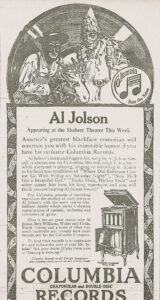 published.
published.
However, a huge, Columbia Records display ad, which ran while the show was in town, depicts Jolson in his Gus Jackson/Friday character, in blackface, beside what appears to be the Robinson Crusoe character. The ad promotes “Al Jolson’s latest and biggest hit, sung by Al Jolson himself….”
A display ad for the show itself has only a chorus girl pictured, but AL JOLSON is listed above the show’s title for the first time–at least in KC. #
°°°°°°°°°°°°°°°
Head and shoulders etching of Mabel Wotten, followed by advance blurb:
 Mabel Wotten, the youthful prima donna of “Robinson Crusoe Jr.,” in which Al Jolson is starring at the Shubert.
Mabel Wotten, the youthful prima donna of “Robinson Crusoe Jr.,” in which Al Jolson is starring at the Shubert.
